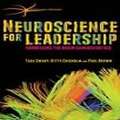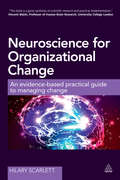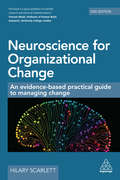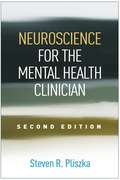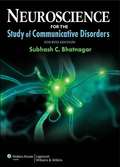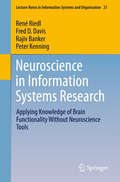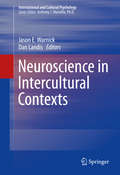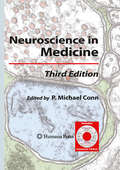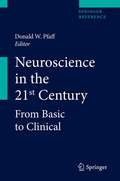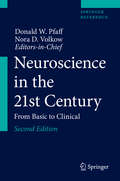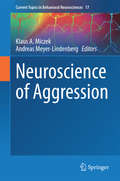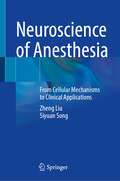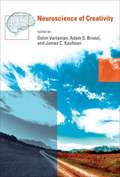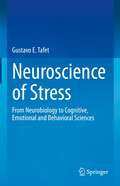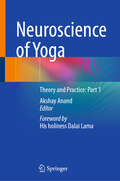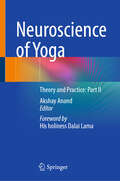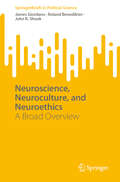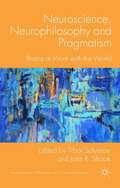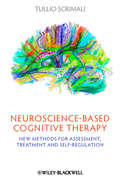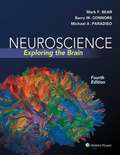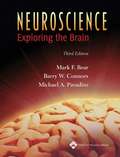- Table View
- List View
Neuroscience for Leaders: Practical Insights to Successfully Lead People and Organizations
by Dr Nikolaos Dimitriadis Dr Alexandros PsychogiosUnlock your potential with the latest neuroscientific insights and succeed as a leader in complex business environments.As understanding of neuroscience increases, it is better understood how scientific insights can be applied to develop and enhance leadership. Neuroscience for Leaders captures the most up-to-date and important findings in neuroscience and links these to the business world. This guide offers a simple framework to put these principles into practice to make better decisions, take the right actions and find faster solutions.Now in its second edition, this book presents a comprehensive approach to leading people and organizations based on academic research. The authors' 'Brain Adaptive Leadership' approach offers a step-by-step guide to enhancing the way leaders think, understanding and nurturing emotions, shaping automated brain responses and developing dynamic relationships. Examples, activities and practical suggestions are all designed to be clear and engaging. Neuroscience for Leaders is the essential guide for leaders who are ready to gain the business advantage scientifically.
Neuroscience for Leadership
by Paul Brown Tara Swart Kitty ChisholmLeadership can be learned: new evidence from neuroscience clearly points to ways that leaders can significantly improve how they engage with and motivate others, allowing them and their organizations to continue discovering their potential. This book provides leaders and managers with a guide to practical, effective actions, based on neuroscience, explained in an accessible way. It focuses on the competencies and capabilities that leaders and managers need, to think creatively, take good decisions, improve their performance and resilience, deal with complexity, incentivize, and innovate, rather than focusing on brain regions or even functional pathways within the brain. This book comes from three authors who combine knowledge and experience in applied neuroscience, psychiatry, organizational psychology, learning and leadership coaching at a world class level.
Neuroscience for Learning and Development
by Stella CollinsNeuroscience for Learning and Development is about the psychology and neuroscience that underpins effective and successful training and learning. It introduces the latest research and concepts and suggests practical tools, techniques and ideas to improve how trainers train and how people learn. Readers will find new and more effective ways of working and will discover a sound basis for good practice. They will also discover the research that backs up what they are already doing well and evidence to support future projects and plans in order to make a convincing case to budget holders. Neuroscience for Learning and Development covers the design and delivery of face-to-face, online and virtual learning as well as how to create environments which make learning easier. It provides evidence to stop training and learning being seen as 'soft and fluffy' and will help trainers and L&D teams persuade the rest of their organization of their value. This book explains the science behind creative training delivery so that learners will be motivated, enjoy training, pay attention, remember what they learn and be able to apply it back at work. It explains the neuroscience of attention, memory and habits and how to make sure people learn what they need to learn. Readers will be able to distinguish the neuromyths from the neuroscience and will find out which elements of brain science offer evidence for current practice and as well as discovering new ideas to continue to develop their skills and practice.
Neuroscience for Organizational Change
by Hilary ScarlettUnderstanding how employees' brains work enables organizations to build cultures, design structures and processes that help people to be more innovative, productive and engaged. This has lasting impact in terms of meeting business objectives and becoming an employer of choice. We need to change the way we manage change in organizations: by understanding the brain we can do this better. Neuroscience brings a new lens through which to look at people and to understand why they react to situations in a certain way, what they need from work relationships to perform at their best, and how they might be better motivated. Neuroscience for Organizational Change not only provides evidence that will persuade the most sceptical of leaders but also provides many practical examples of how to apply the insights. The book provides a 'win-win': it will enable the organization to improve performance and also help to support the mental and emotional well-being of employees. Amongst other areas, Neuroscience for Organizational Change explores why we find organizational change difficult and what we can do to keep people focused and performing at their best. It looks at our need for social connection at work, the essential role that leaders and managers play, how best to manage emotions and reduce bias to avoid making flawed decisions, and why we need communication, involvement and storytelling to help us through change. It also sets out a new science-based planning tool, SPACES, to enhance motivation. Drawing on the author's successful masterclasses, Neuroscience for Organizational Change provides practical guidance and examples from big-name organizations such as Lloyds Banking Group, Department for Business, Innovation and Skills, Orbit Housing Group and BAE Systems. Each chapter includes checklists and questions to help the reader to reflect on what they might take away and apply to the specific context of their own organization.
Neuroscience for Organizational Change: An Evidence-based Practical Guide to Managing Change
by Hilary ScarlettOrganizational change can be unpredictable and stressful. With a better understanding of what our brains need to focus and perform at their best, organizations and leaders can increase employee engagement, productivity and well-being to successfully manage such periods of uncertainty. Drawing on the latest scientific research and verified by an independent neuroscientist, Neuroscience for Organizational Change explores the need for social connection at work, how best to manage emotions and reduce bias in decision-making, and why we need communication, involvement and storytelling to help us through change. Practical tips and suggestions can be found throughout, as well as examples of how these insights have been applied at organizations such as Lloyds Banking Group and GCHQ. The book also sets out a practical science-based planning model, SPACES, to enhance engagement. This updated second edition of Neuroscience for Organizational Change contains new chapters on planning the working day with the brain in mind and on overcoming the difficulties related to behavioural change. It also features up-to-the-minute wider content reflecting the latest insights and developments, and updated case studies from the first edition which give a long-term view of the benefits of applying neuroscience in organizations.
Neuroscience for the Mental Health Clinician, Second Edition
by Steven R. PliszkaAccessible and succinct, this book has given thousands of clinicians and students the basic understanding of neuroscience that is essential in contemporary mental health practice. Steven R. Pliszka synthesizes current knowledge on the neurobiological bases of major psychiatric disorders. He explores the brain systems that underlie cognition, emotions, and behavior; how disturbances in these systems can lead to psychopathology; and the impact of genetic and environmental risk factors across development. The book also addresses the ways that both pharmacological and psychosocial treatments act on the brain as they bring about a reduction in symptoms. Illustrations include 93 black-and-white figures and 14 color plates. New to This Edition *Incorporates over a decade of important advances in brain science. *Heightened focus on brain networks replaces a deficit-based understanding of disorders. *Cutting-edge discussions of genetics and epigenetics, the biological impact of stress, neurotransmitters, novel depression treatments, and other timely topics. *Detailed chapters on autism spectrum disorder and dementia. *Numerous new and revised figures.
Neuroscience for the Study of Communicative Disorders 4th Edition
by Subhash C. Bhatnagar"Neuroscience for the Study of Communicative Disorders, Fourth Edition" takes a step-by-step, simplified approach, and contains relevant information in its application of neuroscience for students and practitioners in speech-language pathology and audiology--making it the perfect text. It remains an ideal resource that teaches neuroscience fundamentals without encyclopedic details of anatomy and physiology, and reflects the most recent findings and clinical applications.
Neuroscience in Information Systems Research
by René Riedl Fred D. Davis Rajiv Banker Peter H. KenningThis book shows how information systems (IS) scholars can effectively apply neuroscience expertise in ways that do not require neuroscience tools. However, the approach described here is intended to complement neuroscience tools, not to supplant them. Written by leading scholars in the field, it presents a review of the empirical literature on NeuroIS and provides a conceptual description of basic brain function from a cognitive neuroscience perspective. Drawing upon the cognitive neuroscience knowledge developed in non-IS contexts, the book enables IS scholars to reinterpret existing behavioral findings, develop new hypotheses and eventually test the hypotheses with non-neuroscience tools. At its core, the book conveys how neuroscience knowledge makes a deeper understanding of IS phenomena possible by connecting the behavioral and neural levels of analysis.
Neuroscience in Intercultural Contexts
by Dan Landis Jason E. WarnickThis breakthrough volume brings together cultural neuroscience and intercultural relations in an expansive presentation. Its selected topics in reasoning, memory, and other key cognitive areas bridge the neuroscience behind culture-related phenomena with the complex social processes involved in seeing the world through the perspective of others. Coverage ranges beyond the familiar paradigms of acculturation and cultural differences to propose new ideas of potential benefit to the new generation of immigrants, negotiators, executives, and other travelers. Taken together, these chapters offer a deeper understanding of issues that can only become more important as the world becomes smaller and our global family larger. Among the topics featured: Intergroup relationship and empathy for others' pain: a social neuroscience approach. The neuroscience of bilingualism: cross-linguistic influences and cognitive effects. Cross-cultural reading the mind in the eyes and its consequences for international relations. Implications of behavioral and neuroscience research for cross-cultural training. Intercultural relations and the perceptual brain: a cognitive neuroscience perspective. How social dynamics shape our understanding of reality. With its elegant perspectives and empirical depth, Neuroscience in Intercultural Contexts is a forward-looking reference for researchers in the cultural sciences (cross-cultural psychologists, anthropologists, etc. ) and in social, affective, and cognitive neuroscience.
Neuroscience in Medicine
by P. Michael ConnContinuing progress has been made in understanding the brain at the molecular, anatomic, and physiological levels in the years following the "Decade of the Brain," with the results providing insight into the underlying basis of many neurological disease processes. In Neuroscience in Medicine, Third Edition, a distinguished panel of basic and clinical investigators, noted for their teaching excellence, provide thoroughly updated and revised chapters to reflect these remarkable advances. Designed specifically for medical students and allied health professionals, this up-to-date edition alternates scientific and clinical chapters that explain the basic science underlying neurological processes and then relate that science to the understanding of neurological disorders and their treatment. These popular and now expanded "clinical correlations" cover, in detail, disorders of the spinal cord, neuronal migration, the autonomic nervous system, the limbic system, ocular motility, and the basal ganglia, as well as demyelinating disorders, stroke, dementia and abnormalities of cognition, congenital chromosomal and genetic abnormalities, Parkinson's disease, nerve trauma, peripheral neuropathy, aphasias, sleep disorders and myasthenia gravis. In addition to concise summaries of the most recent biochemical, physiological, anatomical, and behavioral advances, the chapters summarize current findings on neuronal gene expression and protein synthesis at the molecular level. Authoritative and comprehensive, Neuroscience in Medicine, Third Edition provides a fully up-to-date and readily accessible guide to brain functions at the cellular and molecular level, as well as clearly demonstrating their emerging diagnostic and therapeutic importance.
Neuroscience in the 21st Century
by Donald W. PfaffEdited and authored by a wealth of international experts in neuroscience and related disciplines, the aim behind this key new resource is to offer medical students and graduate researchers around the world a comprehensive introduction and overview of modern neuroscience. Neuroscience research is certain to prove a vital element in combating mental illness in its various incarnations, a strategic battleground in the future of medicine, as the prevalence of mental disorders is becoming better understood each year. Hundreds of millions of people worldwide are affected by mental, behavioral, neurological and substance use disorders. The World Health Organization estimated in 2002 that 154 million people globally suffer from depression and 25 million people from schizophrenia; 91 million people are affected by alcohol use disorders and 15 million by drug use disorders. A more recent WHO report shows that 50 million people suffer from epilepsy and 24 million from Alzheimer's and other dementias. Because neuroscience takes the etiology of disease--the complex interplay between biological, psychological, and sociocultural factors--as its object of inquiry, it is increasingly valuable in understanding an array of medical conditions. A recent report by the United States' Surgeon General cites several such diseases: schizophrenia, bipolar disorder, early-onset depression, autism, attention deficit/ hyperactivity disorder, anorexia nervosa, and panic disorder, among many others. Not only is this volume a boon to those wishing to understand the future of neuroscience, it also aims to encourage the initiation of neuroscience programs in developing countries, featuring as it does an appendix full of advice on how to develop such programs. With broad coverage of both basic science and clinical issues, comprising 106 chapters from a diversity of international authors and including complementary video components, Neuroscience in the 21st Century will serve as a comprehensive resource to students and researchers alike.
Neuroscience in the 21st Century
by Donald W. Pfaff Nora D. VolkowEdited and authored by a wealth of international experts in neuroscience and related disciplines, this key new resource aims to offer medical students and graduate researchers around the world a comprehensive introduction and overview of modern neuroscience. Neuroscience research is certain to prove a vital element in combating mental illness in its various incarnations, a strategic battleground in the future of medicine, as the prevalence of mental disorders is becoming better understood each year. Hundreds of millions of people worldwide are affected by mental, behavioral, neurological and substance use disorders. The World Health Organization estimated in 2002 that 154 million people globally suffer from depression and 25 million people from schizophrenia; 91 million people are affected by alcohol use disorders and 15 million by drug use disorders. A more recent WHO report shows that 50 million people suffer from epilepsy and 24 million from Alzheimer's and other dementias. Because neuroscience takes the etiology of disease--the complex interplay between biological, psychological, and sociocultural factors--as its object of inquiry, it is increasingly valuable in understanding an array of medical conditions. A recent report by the United States' Surgeon General cites several such diseases: schizophrenia, bipolar disorder, early-onset depression, autism, attention deficit/ hyperactivity disorder, anorexia nervosa, and panic disorder, among many others. Not only is this volume a boon to those wishing to understand the future of neuroscience, it also aims to encourage the initiation of neuroscience programs in developing countries, featuring as it does an appendix full of advice on how to develop such programs. With broad coverage of both basic science and clinical issues, comprising around 150 chapters from a diversity of international authors and including complementary video components, Neuroscience in the 21st Century in its second edition serves as a comprehensive resource to students and researchers alike.
Neuroscience of Aggression
by Klaus A. Miczek Andreas Meyer-LindenbergThis volume assembles the leading aggression researchers both at the preclinical and clinical level. They review the current state of knowledge about neural mechanisms of aggressive behavior and point to the need for innovative methodologies to further our understanding of this greatly understudied set of behaviors.
Neuroscience of Anesthesia: From Cellular Mechanisms to Clinical Applications
by Zheng Liu Siyuan SongThis book provides an in-depth exploration of the intricate relationship between anesthesia and brain function. This comprehensive guide delves into the physiological and pharmacological aspects of neuroanesthesia, highlighting the impact of various anesthetic agents on cerebral dynamics. Key topics include the mechanisms of intracranial pressure regulation, cerebral blood flow, and metabolic processes, alongside advanced brain monitoring techniques such as EEG, evoked potentials, and cerebral oxygenation metrics. Aimed at medical professionals, this book addresses the critical need for enhanced understanding and management of brain physiology during anesthesia. It seeks to solve the challenges of maintaining cerebral homeostasis and preventing neurological complications during surgical procedures. By offering evidence-based insights and practical applications, the book equips anesthesiologists, neurologists, and neurosurgeons with the knowledge to improve patient outcomes.
Neuroscience of Creativity
by James C. Kaufman Oshin Vartanian Adam S. BristolThis volume offers a comprehensive overview of the latest neuroscientific approaches to the scientific study of creativity. In chapters that progress logically from neurobiological fundamentals to systems neuroscience and neuroimaging, leading scholars describe the latest theoretical, genetic, structural, clinical, functional, and applied research on the neural bases of creativity. The treatment is both broad and in depth, offering a range of neuroscientific perspectives with detailed coverage by experts in each area. Following opening chapters that offer theoretical context, the contributors discuss such issues as the heritability of creativity; creativity in patients with brain damage, neurodegenerative conditions, and mental illness; clinical interventions and the relationship between psychopathology and creativity; neuroimaging studies of intelligence and creativity; neuroscientific basis of creativity-enhancing methodologies; and the information-processing challenges of viewing visual art. ContributorsBaptiste Barbot, Mathias Benedek, David Q. Beversdorf, Aaron P. Blaisdell, Margaret A. Boden, Dorret I. Boomsma, Adam S. Bristol, Shelley Carson, M. H. M. de Moor, Andreas Fink, Liane Gabora, Dennis Garlick, Elena L. Grigorenko, Richard J. Haier, Rex E. Jung, James C. Kaufman, Helmut Leder, Kenneth J. Leising, Bruce L. Miller, Apara Ranjan, M. P. Roeling, W. David Stahlman, Mei Tan, Pablo P. L. Tinio, Oshin Vartanian, Indre V. Viskontas, Dahlia W. Zaidel
Neuroscience of Creativity (The\mit Press Ser.)
by James C. Kaufman Oshin Vartanian Adam S. BristolExperts describe current perspectives and experimental approaches to understanding the neural bases of creativity. This volume offers a comprehensive overview of the latest neuroscientific approaches to the scientific study of creativity. In chapters that progress logically from neurobiological fundamentals to systems neuroscience and neuroimaging, leading scholars describe the latest theoretical, genetic, structural, clinical, functional, and applied research on the neural bases of creativity. The treatment is both broad and in depth, offering a range of neuroscientific perspectives with detailed coverage by experts in each area. The contributors discuss such issues as the heritability of creativity; creativity in patients with brain damage, neurodegenerative conditions, and mental illness; clinical interventions and the relationship between psychopathology and creativity; neuroimaging studies of intelligence and creativity; the neuroscientific basis of creativity-enhancing methodologies; and the information-processing challenges of viewing visual art.ContributorsBaptiste Barbot, Mathias Benedek, David Q. Beversdorf, Aaron P. Blaisdell, Margaret A. Boden, Dorret I. Boomsma, Adam S. Bristol, Shelley Carson, Marleen H. M. de Moor, Andreas Fink, Liane Gabora, Dennis Garlick, Elena L. Grigorenko, Richard J. Haier, Rex E. Jung, James C. Kaufman, Helmut Leder, Kenneth J. Leising, Bruce L. Miller, Apara Ranjan, Mark P. Roeling, W. David Stahlman, Mei Tan, Pablo P. L. Tinio, Oshin Vartanian, Indre V. Viskontas, Dahlia W. Zaidel
Neuroscience of Stress: From Neurobiology to Cognitive, Emotional and Behavioral Sciences
by Gustavo E. TafetThis textbook provides an introduction to the interdisciplinary study of stress, helping students and professionals understand the main neurobiological and psychological causes and consequences of stress in human beings. It’s aimed at understanding the concept of stress at different levels, from the impact of environmental stressors to its processing in the brain, and from the neural mechanisms involved in this processing to the expression of different adaptive responses. All these neural mechanisms are clearly explained according to different levels of complexity, from the neurobiological level, including the cellular and molecular mechanisms, to the psychological level, including the cognitive and emotional processing, and behavioral expressions.The whole content is described in a very comprehensive manner, accompanied with descriptive graphics to clearly illustrate every detail, therefore allowing a full integration of all the covered concepts. In addition, clinical expressions of stress, such as mood and anxiety disorders, are also covered in detail, including an overview of different factors of vulnerability and resilience, therefore providing a unique and fundamental insight of this interdisciplinary field. Given its interdisciplinary approach, Neuroscience of Stress: From Neurobiology to Cognitive, Emotional and Behavioral Sciences will provide a comprehensive and clear introduction to the study of stress to students and professionals from different fields of the behavioral and health sciences. It will serve as a valuable text for adoption in classes of a wide range of graduate courses dealing with mental health and well-being, in areas such as health and clinical psychology, health promotion and disease prevention, psychiatry and behavioral medicine, among others.
Neuroscience of Yoga: Theory and Practice: Part 1
by Akshay Anand Pooja NadholtaThis book covers experimental theory and practice of yoga that have enhanced its neuroscientific understanding. This is an excellent handbook for the researchers in the field of evidence-based integrative health. It encompasses traditional and modern tools used in neuroscience. It also provides information for the modern biologists, physicians and policymakers, of how mind-body complexities in neuroscience, mental health and preventive healthcare can be useful for health and disease. It serves as a guide for integrative health practitioners, patients, educationists, philosophers, graduate students and faculty pursuing research in the field of biology, complimentary medicine, and other alternative therapies. The chapters in this book also serve as a comprehensive resource for clinical trials in Yoga. In addition, flow charts and illustrations have been provided to understand how healthy brain ageing can be achieved.
Neuroscience of Yoga: Theory and Practice: Part II
by Akshay Anand Pooja NadholtaThis part of the book offers a multidimensional exploration of the neuroscience of yoga and in-depth insights into the neuroscientific underpinnings of yoga's impact on different disease conditions; explores the fascinating intersections between yoga, education, and neuroeconomics, as well as the relationship between yoga, spirituality, and consciousness; and acknowledges the importance of animal models in yoga research. In addition, the book addresses the concept of mind wandering and knowledge practice gap. This section provides valuable guidance for policymakers, healthcare professionals, and educators by exploring these aspects. Its comprehensive nature makes it an invaluable resource for researchers, practitioners, and individuals interested in unravelling the scientific complexities of the mind-body connection.
Neuroscience, Consciousness and Spirituality
by Wayne B. Jonas Harald Walach Stefan SchmidtNeuroscience, Consciousness and Spirituality presents a variety of perspectives by leading thinkers on contemporary research into the brain, the mind and the spirit. This volumes aims at combining knowledge from neuroscience with approaches from the experiential perspective of the first person singular in order to arrive at an integrated understanding of consciousness. Individual chapters discuss new areas of research, such as near death studies and neuroscience research into spiritual experiences, and report on significant new theoretical advances. From Harald Walach's introductory essay, "Neuroscience, Consciousness, Spirituality - Questions, Problems and Potential Solutions," to the concluding chapter by Robert K. C. Foreman entitled "An Emerging New Model for Consciousness: The Consciousness Field Model," this book represents a milestone in the progress towards an integrated understanding of spirituality, neuroscience and consciousness. It is the first in a series of books that are dedicated to this topic.
Neuroscience, Neuroculture, and Neuroethics: A Broad Overview (SpringerBriefs in Political Science)
by John R. Shook Roland Benedikter James GiordanoContemporary brain research is challenging Western societal norms by questioning basic cornerstones such as individuality, freedom, rationality, solidarity, and the concept of the human being in general. It is giving way to profound changes in Western concepts of culture and civilization. This volume provides a broad overview of the cultural changes incurred by neuroscience and neurotechnology, and explores the evolving fields of neuroeconomics, neuroreligion, neuropolitics, and neuroethics. It takes a multi-disciplinary approach in explaining how neuroscience and neurotechnology will affect society, and illustrates how these tools and methods are being used in research and ever-expanding practices in varying fields. Praise for Neuroscience, Neuroculture, and Neuroethics: A Broad Overview “Giordano, Benedikter and Shook provide an accessible, timely, and engaging introduction to the main challenges of neuroscience and neurotechnology for individuals and society. It is impressively wide-ranging, insightfully examining philosophical, cultural, political, and economic dimensions of brain science. An especially fascinating aspect of the book is discussion of the implications of bioenhancement for transhumanism and how it could influence how we define who we are.” --Walter Glannon, Professor Emeritus of Philosophy, University of Calgary, Canada “This book provides an excellent survey about the challenging ‘Neuro-World’. It reflects the different perspectives which are relevant for modern societies. It is full of information to gather additional knowledge on an international and interdisciplinary level.” --Prof. Dr. Ernst Pöppel, Professor of Medical Psychology, Ludwig Maximilian University (LMU) of Munich, Germany “This engaging and highly accessible book offers an excellent short introduction to the powerful impact of neuroscience and neurotechnology upon modern societies. Covering a broad range of issues and perspectives from neuroscience, social science, philosophy, and ethics, it is eminently suitable for teaching and provides a thought-provoking basis for further discussions.” --Kathinka Evers, Professor of Philosophy, Senior Researcher in Philosophy at the Centre for Research Ethics & Bioethics (CRB) at Uppsala University, Sweden; and Professor Ad Honorem at the Universidad Central de Chile
Neuroscience, Neurophilosophy and Pragmatism
by John R. Shook Tibor SolymosiBringing together active neuroscientists, neurophilosophers, and scholars this volume considers the prospects of a neuroscientifically-informed pragmatism and a pragmatically-informed neuroscience on issues ranging from the nature of mental life to the implications of neuroscience for education and ethics.
Neuroscience-based Cognitive Therapy
by Tullio ScrimaliA pioneer of CBT explores recent advances in neuroscience, showing how they can be applied in practice to improve the effectiveness of cognitive therapy for clients with a wide range of diagnoses including mood disorders, anxiety disorders, eating disorders and schizophrenia Utilizes the latest advances in neuroscience to introduce tools that allow clinicians, for the first time, to directly 'measure' the effectiveness of cognitive therapy interventions Rigorously based in neuroscientific research, yet designed to be readable and jargon-free for a professional market of CBT practitioners Covers theory, assessment, and the treatment of a wide range of specific disorders including anxiety disorders, mood disorders, eating disorders, addictions and schizophrenia Written by a respected pioneer in the field
Neuroscience: Exploring The Brain (Fourth Edition)
by Mark F. Bear Michael A. Paradiso Barry W. ConnorsAcclaimed for its clear, friendly style, excellent illustrations, leading author team, and compelling theme of exploration, Neuroscience: Exploring the Brain, 4e takes a fresh, contemporary approach to the study of neuroscience, emphasizing the biological basis of behavior. The authors' passion for the dynamic field of neuroscience is evident on every page, engaging students and helping them master the material. In just a few years, the field of neuroscience has been transformed by exciting new technologies and an explosion of knowledge about the brain. The human genome has been sequenced, sophisticated new methods have been developed for genetic engineering, and new methods have been introduced to enable visualization and stimulation of specific types of nerve cells and connections in the brain. The new Fourth Edition has been fully updated to reflect these and other rapid advances in the field, while honoring its commitment to be student-friendly with striking new illustrations, additional animations, and an unparalleled array of online resources.
Neuroscience: Exploring the Brain (Third Edition)
by Mark F. Bear Barry W. Conners Michael A. ParadisoNeuroscience: Exploring the Brain surveys the organization and function of the human nervous system, presenting material at the cutting edge of neuroscience, in a way that is accessible to both science and nonscience students alike. The book is divided into four parts: Part I, Foundations; Part II, Sensory and Motor Systems; Part III, The Brain and Behavior; and Part IV, The Changing Brain.

